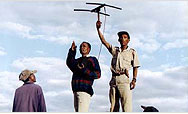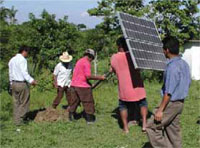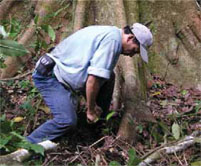 |
 |
 |
|||||||
Addressing the causes and effects of climate change has been a key focus of USAID's development assistance for over a decade. USAID has funded environmental programs that have reduced greenhouse gas emissions while promoting energy efficiency,forest protection, biodiversity conservation, and other development goals. This “multiple benefits” approach to climate change helps developing and transition countries achieve economic development without sacrificing environmental protection. To help countries address domestic and international climate change priorities, USAID’s Global Climate Change Program is active in more than 40 countries and, since 2001, has dedicated over a billion U.S. dollars to promote:
The Latin America and the Caribbean (LAC) region boasts abundant water tremendous biological diversity, and approximately half of the tropical forests in the world. However, population growth, deforestation, urban expansion, and pollution threaten the region’s environment and raise the potential for conflict. USAID’s environment programs in the LAC region seek to mitigate these challenges, creating the potential for long-term economic benefit from the use of the region’s natural resources. USAID’s Global Climate Change Program is active bilaterally in countries such as Bolivia, Brazil, Ecuador, Mexico, Paraguay, and Peru, as well as throughout the Central American region. Clean Energy TechnologyNew technologies and practices offer the prospect for continued economic growth with reduced greenhouse gas emissions. Recognizing that increased productivity and efficiency are critical to economic growth, USAID supports the commercialization, dissemination, and widespread adoption of environmentally sound technologies. Attracting private investment is essential to popularizing such technologies. In Brazil, USAID is working with local partners to demonstrate that renewable energy technologies (solar, biomass, wind, and small-scale hydropower plants) are technically and economically viable. Programs include solar energy technologies for drying fruit, pollen, and marine algae; solar-powered water pumps for irrigating small organic family farms; and replicable renewable energy-based projects to provide access to energy services to isolated communities in the Amazon. In Mexico, USAID is working to reduce greenhouse gas emissions through the promotion of cleaner production and renewable energy. Support for off-grid renewable energy programs for small scale applications in four states - Veracruz, Guerrero, Oaxaca and Chiapas - have improved local economic conditions and increased capacity in responding to climate related challenges. USAID/Mexico is also providing technical assistance to the Mexican Ministry of Environment to reduce methane emissions and increase energy supply through a series of demonstration activities in the areas of landfills, agricultural waste, and in the oil and gas sectors. Sustainable Land Use and Forestry
Promoting biodiversity conservation, improved forest management, and sustainable agriculture, USAID programs help mitigate climate change by absorbing and storing carbon dioxide from the atmosphere. They also help reduce the vulnerability of ecosystems to climate change. Reduced-impact logging of forests minimizes loss of vegetative cover, for instance, which helps stabilize the soil and control erosion during rain and wind storms. Reduced tillage and contour planting by farmers increase soil organic carbon and therefore enhance soil fertility, which helps increase food security in developing countries. Through the Bolivian Forest Project, USAID seeks to improve business practices for forestry exports and broaden the benefits by including more community forest operations. As a result of investments catalyzed by USAID, nine million of the country’s 32 million hectares of designated forest production lands are under sustainable management plans. Bolivia is now also the global leader in certified natural tropical forest management. Certification provides market recognition of sustainable forest management and therefore a potential incentive to producers through linkages to a growing “green” market. Adaptation to Climate ChangeUSAID supports activities to help developing countries lessen their vulnerability and adapt to climate variability and change. These activities are intended to build more resilience into economic sectors that may be affected by climatic stresses, including agriculture, water, and key livelihood sectors in coastal areas. USAID is working throughout the LAC region to prepare for climate related disasters such as forest fires from drought, and flooding from hurricanes and stronger than normal rains. In Guatemala, USAID strengthened the competitiveness and management of community forest concessions and prevented forest fires in the Mayan Biosphere Reserve in Peten. In Mexico, USAID helped to design and propose pilot activities in Guanajuato and Oaxaca for integrated local water management by water user associations under a Sustainable Aquifers Initiative, which brings together energy efficiency, water conservation, agricultural technologies, and local management initiatives. Finally, in Honduras, efforts to prepare for future climate variability include a USAID project in La Ceiba to improve urban planning to increase resilience to coastal and riverine flooding. Climate Science for Decision MakingUSAID is also involved in U.S. and international climate change research to ensure that science produces information needed for global development challenges and that scientific findings guide development planning. Informed policy decisions are essential to sustainable natural resource management and economic development, key priorities of USAID. In the Central America region, USAID is collaborating with NASA and Central American organizations to strengthen regional capacity to analyze and utilize remotely sensed information to interpret land cover and land use change data, model climate change impacts, and assess vulnerability and potential adaptive responses to climate change. The results will be used in the countries’ national communications submitted to the U.N. Framework Convention on Climate Change. Predictive and descriptive tools will help local governments and communities maintain economic growth when confronted by events such as fires, floods, red tides, hurricanes, volcanic eruptions, and earthquakes. Download the Global Climate Change Program: Latin America and the Caribbean, April 2007 (PDF 302K) |
|||||||||
|


